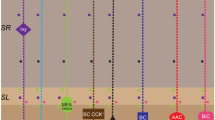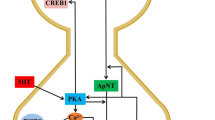Abstract
The active dendritic conductances shape the input-output properties of many principal neurons in different brain regions, and the various ways in which they regulate neuronal excitability need to be investigated to better understand their functional consequences. Using a realistic model of a hippocampal CA1 pyramidal neuron, we show a major role for the hyperpolarization-activated current, I h , in regulating the spike probability of a neuron when independent synaptic inputs are activated with different degrees of synchronization and at different distances from the soma. The results allowed us to make the experimentally testable prediction that the I h in these neurons is needed to reduce neuronal excitability selectively for distal unsynchronized, but not for synchronized, inputs.
Similar content being viewed by others
References
Andrasfalvy BK, Magee JC (2001) Distance-dependent increase in AMPA receptor number in the dendrites of adult hippocampal CA1 pyramidal neurons. J. Neurosci. 21: 9151-9159.
Bilkey DK, Schwartzkroin PA (1990) Variation in electrophysiology and morphology of hippocampal CA3 pyramidal cells. Brain Res. 514: 77-83.
Brewster A, Bender RA, Chen Y, Dube C, Eghbal-Ahmadi M, Baram TZ (2002) Developmental febrile seizures modulate hippocampal gene expression of hyperpolarization-activated channels in an isoform-and cell-specific manner. J. Neurosci. 22: 4591-4599.
Chen K, Aradi I, Thon N, Eghbal-Ahmadi M, Baram TZ, Soltesz I (2001) Persistently modified h-channels after complex febrile seizures convert the seizure-induced enhancement of inhibition to hyperexcitability. Nat. Med. 7: 331-337.
Chrobak JJ, Buzsáki G (1998) Gamma oscillations in the Entorhinal Cortex of the freely behaving rat. J. Neurosci. 18: 388-398.
Destexhe A, Mainen ZF, Sejnowski TJ (1994) An efficient method for computing synaptic conductances based on a kinetic model of receptor binding. Neural Comp. 6: 10-14.
Destexhe A, Pare D (1999) Impact of network activity on the integrative properties of neocortical pyramidal neurons in vivo. J. Neurophysiol. 81: 1531-1547.
Dickson CT, Mena AR, Alonso A (1997) Electroresponsiveness of medial entorhinal cortex layer III neurons in vitro. Neuroscience 81: 937-950.
Frank LM, Brown EN, Wilson MA (2001) A comparison of the firing properties of putative excitatory and inhibitory neurons from CA1 and the entorhinal cortex. J. Neurophysiol. 86: 2029-2040.
Hines M, Carnevale T (1997) The NEURON simulation environment. Neural Comp. 9: 178-1209.
Hoffman DA, Magee JC, Colbert CM, Johnston D (1997) K+ channel regulation of signal propagation in dendrites of hippocampal pyramidal neurons. Nature 387: 869-875.
Ho N, Destexhe A (2000) Synaptic background activity enhances the responsiveness of neocortical pyramidal neurons. J. Neurophysiol. 84: 1488-1496.
Jahr CE, Stevens CF (1990) A quantitative description of NMDA receptor-channel kinetic behavior. J. Neurosci. 10: 1830-1837.
Jahr CE, Stevens CF (1990b) Voltage dependence of NMDA-activated macroscopic conductances predicted by single-channel kinetics. J. Neurosci. 10: 3178-3182.
Johnston D, Amaral DG (1998) Hippocampus In: GM Shepherd, ed. The Synaptic Organization of the Brain, 4th ed. Oxford Univ. Press, New York, pp. 417-458.
Luthi A, McCormick DA (1999) Modulation of a pacemaker current through Ca(2+)-induced stimulation of cAMP production. Nat. Neurosci. 2: 634-641.
Magee JC (1998) Dendritic hyperpolarization-activated currents modify the integrative properties of hippocampal CA1 pyramidal neurons. J. Neurosci. 18: 7613-7624.
Magee JC (1999) Dendritic Ih normalizes temporal summation in hippocampal CA1 neurons. Nat Neurosci. 2: 508-514.
Magee JC, Cook E (2000) Somatic EPSP amplitude is independent of synapse location in hippocampal pyramidal neurons. Nature Neurosci. 3: 895-903.
Megias M, Emri Z, Freund TF, Gulyas AI (2001) Total number and distribution of inhibitory and excitatory synapses on hippocampal CA1 pyramidal cells. Neuroscience 102: 527-540.
Migliore M (2003) On the integration of subthreshold inputs from Perforant Path and Schaffer collaterals in hippocampal CA1 neurons. J. Comput. Neurosci. 14: 185-192.
Migliore M, Hoffman DA, Magee JC, Johnston D (1999) Role of an A-type K+ conductance in the back-propagation of action potentials in the dendrites of hippocampal pyramidal neurons. J. Comput. Neurosci. 7: 5-16.
Migliore M, Shepherd GM (2002) Emerging rules for the distributions of active dendritic conductances. Nature Rev. Neurosci. 3: 362-370.
Penny WD, Kiebel SJ, Kilner JM, Rugg MD (2002) Event-related brain dynamics. Trends Neurosci. 25: 387-389.
Poolos NP, Migliore M, Johnston D (2002) Pharmacological upregulation of h-channels selectively reduces the excitability of pyramidal neuron dendrites. Nature Neurosci. 5: 767-774.
Spruston N, Schiller Y, Stuart G, Sakmann B (1995) Activity-dependent action potential invasion and calcium influx into hippocampal CA1 dendrites. Science 268: 297-300.
Stricker C, Field AC, Redman SJ (1996) Statistical analysis of amplitude fluctuations in EPSCs evoked in rat CA1 pyramidal neurones in vitro. J. Physiol. 490: 419-441.
Suzuki SS, Smith GK (1985) Burst characteristics of hippocampal complex spike cells in the awake rat. Exp. Neurol. 89: 90-95.
Traub RD, Whittington MA, Colling SB, Buzsaki G, Jefferys JG (1996) Analysis of gamma rhythms in the rat hippocampus in vitro and in vivo. J. Physiol. 493: 471-484.
Vargas G, Lucero MT (2002) Modulation by PKA of the hyperpolarization-activated current (Ih) in cultured rat olfactory receptor neurons. J. Membr. Biol. 188: 115-125.
Vasilyev DV, Barish ME (2002) Postnatal development of the hyperpolarization-activated excitatory current Ih in mouse hippocampal pyramidal neurons. J. Neurosci. 22: 8992-9004.
Watanabe S, Hoffman DA, Migliore M, Johnston D (2002) Dendritic K+ channels contribute to spike-timing dependent long-term potentiation in hippocampal pyramidal neurons. Proc. Natl. Acad. Sci. USA 99: 8366-8371.
Williams SR, Stuart GJ (2000) Site independence of EPSP time course is mediated by dendritic I(h) in neocortical pyramidal neurons. J Neurophysiol 83: 3177-3182.
Author information
Authors and Affiliations
Rights and permissions
About this article
Cite this article
Migliore, M., Messineo, L. & Ferrante, M. Dendritic I h Selectively Blocks Temporal Summation of Unsynchronized Distal Inputs in CA1 Pyramidal Neurons. J Comput Neurosci 16, 5–13 (2004). https://doi.org/10.1023/B:JCNS.0000004837.81595.b0
Issue Date:
DOI: https://doi.org/10.1023/B:JCNS.0000004837.81595.b0




